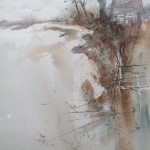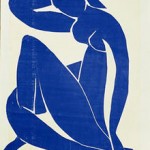
When it comes to artistic composition, you can study art from an instructor, read a great many books on the subject, or search the internet for all the suggested “rules” that apply. But for me, I only accept the principles that underlie the fundamental issues of these rules, and this is: to captivate the attention of the viewers and direct them to the important area of interest. By doing this, it should hold their attention as long as possible. This is the objective, and any method used to accomplish it should be considered okay.

From the small watercolor sketch on the left, I created what I consider a more directional composition on the right. I usually will make several small sketches (usually using graphite pencil instead of paint) of different compositions before settling on what I consider strong enough to be an artistic composition. Here are a few tips to consider when you are trying to decide on a composition.

Tip: Keep it simple. No–I’m not talking about keeping it as simple as the thumbnail on the right unless the subject you choose to paint is as simple as this one. As a matter of fact, your subject may be very complex and the size of your painting may be very large or small. I’m talking about the compositional quality of the painting should have an overall simplicity about it.

Tip: Concentrate on harmony~Use differing methods to keep harmony in your painting. This could be in the way you use your colors; such as, using a limited palette as was done in the painting on the left, Serenity in the Keys (Please ignore the camera flash showing in the middle of the painting). In many cases, it is the way you use light–a single source of light on the subject. There are other devices you can use that will be as effective: control edges with precision; an integrated linear pattern; a combination of all these elements, selecting one and using it more dominantly. Overall, harmony is an element that acts as a unifying device and is very important in captivating the attention of the viewer.

Tip: Keep it interesting–not so easy to describe~Use subtlety in your painting. A pictorial composition that is so obvious will defeat the purpose of the artist. Remember, you are trying to entertain and drive the eyes of the viewer by keeping different parts of the picture interesting. In Lynn Burton’s painting on the right, Chief and Skull, you know you are looking at a “Southwestern” painting. But is there more to it? Notice how the horns on the buffalo skull the chief is holding blend into the darker color of the feathers which circles his head in a way which makes us concentrate on his face. And what story is told in the painted skulls on the symbols to the left. You cannot look at them without pausing to do so on purpose. However, the repetition of the four buffalo skulls automatically drive your eyes back to the similar shape of the larger skull the chief is holding, and drives your eyes upward to the horns, which makes you focus right back on the face of the chief. In other words, you keep coming back to the center of interest. Clever artwork, isn’t it? Now, did the artist have any idea he was doing this? I never asked, but I bet he did.
